27 Jul 2009
Some Notes from the Final Day of TED Global in Oxford
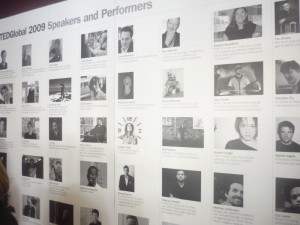 The first session of the last day was ‘Cities Past and Future’. First speaker was Eric Sanderson, who gave an absolutely mesmering presentation about his work on the Mannahatta Project. It is based around asking the question, what would the land on which New York now stands have looked like in the 1600s when Hudson first rowed up the river? A simple question, but the results of the work combine cartography, GIS, biology, ethanography, and much much more. Early on in their work, Eric found in a library a map, made during the US Revolution by British engineers, a survey of the area. It is a remarkably accurate and detailed map, and Eric and his team set about overlaying the current plan of New York on top of it. The idea was to be able to move backwards in time and see how the city emerged. They mapped the basic aspects of island, its soils, ecology, its native peoples, its flora and fauna., its birds, bears, bees and beavers.
The first session of the last day was ‘Cities Past and Future’. First speaker was Eric Sanderson, who gave an absolutely mesmering presentation about his work on the Mannahatta Project. It is based around asking the question, what would the land on which New York now stands have looked like in the 1600s when Hudson first rowed up the river? A simple question, but the results of the work combine cartography, GIS, biology, ethanography, and much much more. Early on in their work, Eric found in a library a map, made during the US Revolution by British engineers, a survey of the area. It is a remarkably accurate and detailed map, and Eric and his team set about overlaying the current plan of New York on top of it. The idea was to be able to move backwards in time and see how the city emerged. They mapped the basic aspects of island, its soils, ecology, its native peoples, its flora and fauna., its birds, bears, bees and beavers.
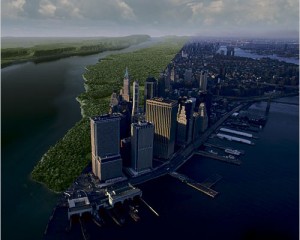 The result is stunning computer generated images of Mannahatta (as the native peoples called it) before it was developed and populated. That work in itself, as a tool for understanding one’s bioregion, is the most thorough, poetic, compelling and fascinating such study I have ever seen (his book is incredible, the only book I return home from TED with, and which I will review after the summer break). But what they have then gone on to do, which is fascinating to Transition folks, is to then roll forward, to imagine what New York might look like if it has gone some considerable way towards reintegrating some of the ecology that was there before, reintroducing some of the rivers, the trees and so on, as part of a Transitioned, more resilient city. Brilliant.
The result is stunning computer generated images of Mannahatta (as the native peoples called it) before it was developed and populated. That work in itself, as a tool for understanding one’s bioregion, is the most thorough, poetic, compelling and fascinating such study I have ever seen (his book is incredible, the only book I return home from TED with, and which I will review after the summer break). But what they have then gone on to do, which is fascinating to Transition folks, is to then roll forward, to imagine what New York might look like if it has gone some considerable way towards reintegrating some of the ecology that was there before, reintroducing some of the rivers, the trees and so on, as part of a Transitioned, more resilient city. Brilliant.
Next was Constanza Ceruti, a ‘high altitude archaeologist’, who studies archeaological sites on the tops of mountains around the world, finding evidence of those peoples who saw them as sacred places. One of the telling parts was when she spoke of one place where for centuries the people had a ritual where once a year they would go up the mountain to the glacier, chip lumps of ice which they would bring back to their homes as a blessing. Now, with the shrinking of the glacier, they have to bring home plastic bottles of water instead.
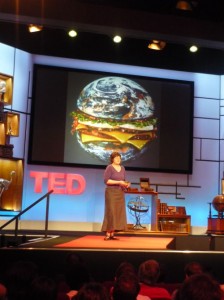 Next was Carolyn Steel, author of the excellent ‘Hungry Cities’. Her talk was one of the highlights for me, and in the context of Paul Romer the previous day asking why people hadn’t built new cities in the desert, here was a powerful articulation of why not. Because the starting point of any city has always been ‘how will it feed itself?’ We take it for granted when we live in a city that there will always be enough food for everyone, but when you think about it, it is amazing that that happens at all. It has led to a system of agriculture that has profoundly changed the world. She traced the symbiotic evolution of cities and agriculture back 10,000 years to the Fertile Crescent, where temples were, in effect, ‘spiritualised centralised food distribution systems’. The Roman Empire followed, an empire built, as much as anything, to source food for Rome. She described the growth of the Empire as “one long ancient shopping spree’, sourcing food from great distances.
Next was Carolyn Steel, author of the excellent ‘Hungry Cities’. Her talk was one of the highlights for me, and in the context of Paul Romer the previous day asking why people hadn’t built new cities in the desert, here was a powerful articulation of why not. Because the starting point of any city has always been ‘how will it feed itself?’ We take it for granted when we live in a city that there will always be enough food for everyone, but when you think about it, it is amazing that that happens at all. It has led to a system of agriculture that has profoundly changed the world. She traced the symbiotic evolution of cities and agriculture back 10,000 years to the Fertile Crescent, where temples were, in effect, ‘spiritualised centralised food distribution systems’. The Roman Empire followed, an empire built, as much as anything, to source food for Rome. She described the growth of the Empire as “one long ancient shopping spree’, sourcing food from great distances.
London in the 17th century was built around its food supplies, fish and grain markets by the river, still found in street names. It would not have been possible to live in a city and not be aware of where your food came from. This has now become much more invisible, thanks initially to rail and then to suburbia and our present day distribution systems. She looked back through a series of food thinkers, and at the idea of ‘Utopia’, which means simultaneously “good place” and “no place”… it is an idealised thing that cannot actually exist in reality. She has coined a new phrase, ‘sitopia’, or ‘food place’, to articulate the need to use food as a conceptual design tool, that in designing anything, we always think of food first. We can use, she concluded, food as a powerful tool in order to shape our cities for the better.
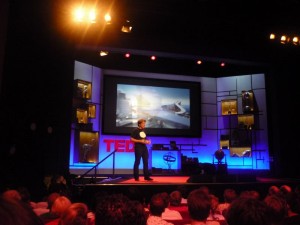 Bjarke Ingels is a young Danish architect who has won many awards for his work. An engaging and entertaining speaker, he talked about his work. This started out OK… he is clearly a talented designer, with good thinking around sustainability, but as the talk wore on, he ventured more and more into the kind of architectural megalomania that architects are often drawn to, creating huge ‘statement’ buildings just because they can. His first buildings were fine, the idea of creating large buildings like mountains so as to maximise the south facing spaces. Then it all got a bit carried away, some ghastly thing he designed in China, and then a project in Azerbajan where 7 huge buildings were to be built, each in the shape of one of the country’s largest mountains. No thoughts of the resource impacts of such a project, and a scale of project that really belonged to the upside of the Age of Cheap Oil, not the downside. Great speaker though.
Bjarke Ingels is a young Danish architect who has won many awards for his work. An engaging and entertaining speaker, he talked about his work. This started out OK… he is clearly a talented designer, with good thinking around sustainability, but as the talk wore on, he ventured more and more into the kind of architectural megalomania that architects are often drawn to, creating huge ‘statement’ buildings just because they can. His first buildings were fine, the idea of creating large buildings like mountains so as to maximise the south facing spaces. Then it all got a bit carried away, some ghastly thing he designed in China, and then a project in Azerbajan where 7 huge buildings were to be built, each in the shape of one of the country’s largest mountains. No thoughts of the resource impacts of such a project, and a scale of project that really belonged to the upside of the Age of Cheap Oil, not the downside. Great speaker though.
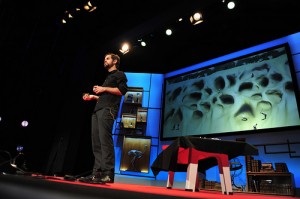 Magnus Larsson is another architect, with an initially interesting idea that got rather carried away with itself, although in his defense, he did put forward his talk as an idea, as the early stages of a concept. His starting point is desertification. Deserts are moving southwards (in Africa) at 1 metre per day. Trees can slow it down, but often they just get cut down for firewood. His solution is to ‘make the dunes inhabitable’, creating a green desert from within. All you need to do, he said, is solidify the sand. How? By using some microorganism that one finds in marshes, one can turn sand into sandstone. It is a far cheaper way than using cement to do the same thing. His idea is to turn the dunes into ‘linear cities’, one long continuous line of dune houses across Africa, which would hold back the sands, while also creating shelter. Conceptually interesting, but I’m sure you could spend this morning coming up with a list of the many reasons why it wouldn’t work in practice (here’s a few to start with: water, food, energy, cost, loneliness, boredom….)
Magnus Larsson is another architect, with an initially interesting idea that got rather carried away with itself, although in his defense, he did put forward his talk as an idea, as the early stages of a concept. His starting point is desertification. Deserts are moving southwards (in Africa) at 1 metre per day. Trees can slow it down, but often they just get cut down for firewood. His solution is to ‘make the dunes inhabitable’, creating a green desert from within. All you need to do, he said, is solidify the sand. How? By using some microorganism that one finds in marshes, one can turn sand into sandstone. It is a far cheaper way than using cement to do the same thing. His idea is to turn the dunes into ‘linear cities’, one long continuous line of dune houses across Africa, which would hold back the sands, while also creating shelter. Conceptually interesting, but I’m sure you could spend this morning coming up with a list of the many reasons why it wouldn’t work in practice (here’s a few to start with: water, food, energy, cost, loneliness, boredom….)
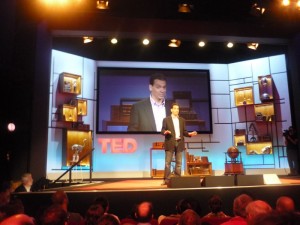 The second session of the afternoon was called ‘Enquire Within’. First up, Dan Pink, who applied observations from science to how to run a business. He showed something called ‘the Candle Problem’ a simple initiative test. When people were presented with it, some were given a cash incentive to solve it, and others were just asked to do it. Logic would tell us that the cash incentive inproved performance, but it didn’t. The opposite was the case. However, he said, there is a mismatch between what science knows and what business does. He looked at various models for how people can be encouraged to give their best at work which include creating time for them to be creative outside of what they already do. He offered the example of wikipedia, as an example of something done using peoples’ passion and enthusiasm, as opposed to Microsoft’s Encarta, which worked in a more traditional way, and was left in the dust by Wikipedia.
The second session of the afternoon was called ‘Enquire Within’. First up, Dan Pink, who applied observations from science to how to run a business. He showed something called ‘the Candle Problem’ a simple initiative test. When people were presented with it, some were given a cash incentive to solve it, and others were just asked to do it. Logic would tell us that the cash incentive inproved performance, but it didn’t. The opposite was the case. However, he said, there is a mismatch between what science knows and what business does. He looked at various models for how people can be encouraged to give their best at work which include creating time for them to be creative outside of what they already do. He offered the example of wikipedia, as an example of something done using peoples’ passion and enthusiasm, as opposed to Microsoft’s Encarta, which worked in a more traditional way, and was left in the dust by Wikipedia.
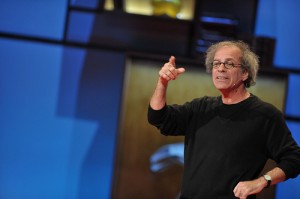 Next was my personal highlight of the whole 2 days I was there. It was so brilliant that I could not do it justice, and you will have to wait for the film of it. Conductor Itay Talgam (left) talked about inspiration and leadership, using the work of famous conductors to illustrate his points. It was stunning stuff, but as I say, you will have to wait for the film!
Next was my personal highlight of the whole 2 days I was there. It was so brilliant that I could not do it justice, and you will have to wait for the film of it. Conductor Itay Talgam (left) talked about inspiration and leadership, using the work of famous conductors to illustrate his points. It was stunning stuff, but as I say, you will have to wait for the film!
Then Daniel Birnbaum, the curator of the Venice Biennale. His talk was about the role of a curator, but I have to say it didn’t do much for me, given that I think that much modern art has become so removed from reality, like some the architecture presented during TED, that it has attained levels of abstraction that make it rather irrelevant. Interesting footage though of a house built as a typical US suburban home being brought up the river to Venice as a centrepiece of the exhibition, sinking in the harbour.
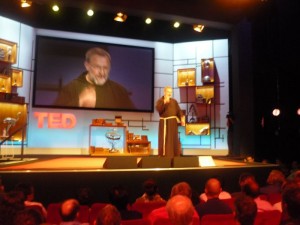 Last speaker was Brother Paulus Terwitte, a Cappuchin monk, who talked about what he saw as the important things in life and the power of silence. Felt like a slightly condescending and patronising conclusion to the event, whereas most other speakers had clearly honed their talks and put a lot of work into them, that Brother Paulus just gave his usual thing, which was disappointing. Anyway, then Tom O’Reilly, one of the organisers, gave a very funny recap of the conference, accompanied by hilarious powerpoint, taking off many of the previous speakers. Final thing was an improvised musical piece from Imogen Heap. Beautiful. A great way to conclude.
Last speaker was Brother Paulus Terwitte, a Cappuchin monk, who talked about what he saw as the important things in life and the power of silence. Felt like a slightly condescending and patronising conclusion to the event, whereas most other speakers had clearly honed their talks and put a lot of work into them, that Brother Paulus just gave his usual thing, which was disappointing. Anyway, then Tom O’Reilly, one of the organisers, gave a very funny recap of the conference, accompanied by hilarious powerpoint, taking off many of the previous speakers. Final thing was an improvised musical piece from Imogen Heap. Beautiful. A great way to conclude.
So, altogether, an extraordinary event. I think that TED is a bit like a really good record shop. As a teenager, I virtually grew up in Revolver Records in Bristol, one of the great independent record shops. The people who worked there were such music obsessives, that usually when you went to the counter clutching whatever record you wanted, they would say “you don’t want to buy that rubbish, listen to THIS”, and then proceed to play you something extraordinary. They were usually right, and you usually went home with their record instead. In the same way, the speakers at TED create an eclectic list which, on first inspection, reveals no-one familiar at all. However, the skill with which they are picked, and the diversity of what they bring, and the professionalism of the whole event, is extraordinary. They are clearly quite an extraordinary organisation, with a great power to communicate powerful ideas. I wish I had been able to make the whole thing. If you haven’t already done so, check out Ted.com for more information.
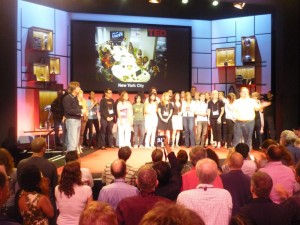
Greenpa
27 Jul 3:04pm
🙂
Says it all, really.